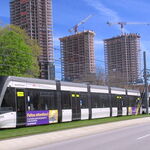crs1026
Superstar
Reading the fine print - the IB is offering support for additional study only.
Yeah - apparently we need more study.
/s
- Paul
Yeah - apparently we need more study.
/s
- Paul
I'm not sure that would paint the government in good light leading into the election.Yeah - apparently we need more study.
I used to take VIA often in those days and I must say the trains very seldom met the 3.59 minute time! However, even after spending $$$ it will be sad if they cannot get (reliably) back to less than 4 hours.Given that VIA used to run it in just under 4 hours historically, before the freight issues started to become so significant, then surely if it's 45 minutes slower when this is finished then that would be a big failure!
Seldom, but occasionally - and early even on very rare occasions.I used to take VIA often in those days and I must say the trains very seldom met the 3.59 minute time! However, even after spending $$$ it will be sad if they cannot get (reliably) back to less than 4 hours.
On that note, what do they need to do other than the grade crossings to get the track to higher speed ready (200km/h+)?
They are right now aiming for a palsy 177km/h which in this age is actually quite slow even for HFR
Seldom, but occasionally - and early even on very rare occasions.
If they can't achieve 4 hours, they need to be looking at using the current alignment. Perhaps it would be cheaper to buy CN, take what they need, and sell the rest off.
To hit 200km/ph + you need complete or pretty close to complete grade separation, at least on the segments where that speed is planned.
You might be able to retain grade crossings in sections where trains would be slower for other reasons.
You also really need track exclusive to the higher speed passenger service. You don't necessarily need an entire corridor, and the separation, theoretically could be temporal.
But you can't run trains clocking that kind of speed w/vastly slower trains operating on the same track at the same time.
Over 200km/ph also requires fairly straight track, and very good quality of rail infrastructure.
Finally, you need the rolling stock that can hit those running speeds.
Its potentially, many Billions of dollars expensive.
That said, if you keep the aim at 200km/ph, and only upgrade 2 or 3 extended line segments to hit the max speed for a 30km-40km stretch............there may be workable economy there somewhere.
Right now, most of us so frustrated at under-investment in the corridor, for so long, we'd be happy w/what's proposed, subject to some question's about to the level of realism of some of the preliminary estimates being subject to greater rigour.
...Canada Infrastructure Bank is supporting the ambitious project in the form of millions of dollars for additional study on how to “de-risk” the project.
Considering that the difference in speed between 177kmh and 200kmh isnt much, id say this isnt worth it until we upgrade the line in the future to to HSR at 250kmh+
To spend billions to maybe shave 30 minutes off the travel time simply isnt worth it.
Reading the fine print - the IB is offering support for additional study only.
Yeah - apparently we need more study.
/s
- Paul
Looks like the CIB is funding further study. Guess that doesn’t mean that much after all.
The CIB is trying hard to prove how useless it is. At this point, I really wouldn’t be upset if they Conservatives killed the outfit.
Looking at the distance - the old Smith Falls to Toronto on the CP through Havelock was 338 km. Add in the 66 km from Smith Falls to Ottawa and current 187 km from Ottawa to Montreal, though from the G&M map, it looks like is shaves off about 5 km north of Coteau, presumably by running along the CP Winchester Subdivision, instead of coming down to Coteau.Considering that the difference in speed between 177kmh and 200kmh isnt much, id say this isnt worth it until we upgrade the line in the future to to HSR at 250kmh+
To spend billions to maybe shave 30 minutes off the travel time simply isnt worth it.
Looking at the distance - the old Smith Falls to Toronto on the CP through Havelock was 338 km. Add in the 66 km from Smith Falls to Ottawa and current 187 km from Ottawa to Montreal, though from the G&M map, it looks like is shaves off about 5 km north of Coteau, presumably by running along the CP Winchester Subdivision, instead of coming down to Coteau.
The total distance from Toronto to Montreal is 586 km (compared to 539 km on the current route).
The average speed then, for the 4.75 hour journey, would be 123 km/hr. Presumably then great extents of the trip wouldn't even be at 177 km/hr.
Compare to the average 135 km/hr speed on the existing track when VIA used to run it in under 4 hours.
Hmm ... if Montreal to Toronto trains stayed alongside the CP Winchester sub instead of going all the way up to Ottawa and back, that would knock off almost 34 km to bring the route length down to 552 km - and less curves. I wonder if that's feasible in the long-run.
Certainly Ottawa to Toronto service should significantly improve. Currently from Smith Falls to Toronto is 380 km as fast as about 3.4 hours. It's only 338 km through Peterborough.
I'm still scratching my head on timings. The best Ottawa to Montreal time is about 1:50. Perhaps this drops to 1:45? Then about an 45 minutes to stop in Ottawa and get to Smith Falls? That leaves about 2:15 to get from Smith Falls to Toronto. I'm scratching my head on how it does Montreal to Toronto in much less than 5:15.
The current ones? Via's timetable.Where you getting these numbers for travel time?




